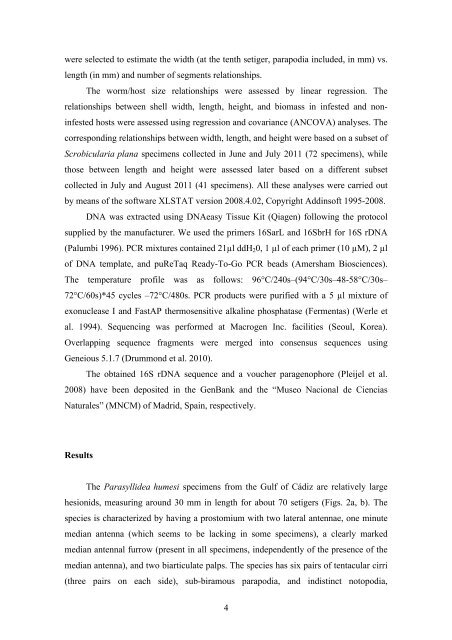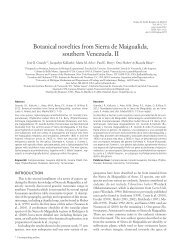Versió d'autor P Hume... - CSIC
Versió d'autor P Hume... - CSIC
Versió d'autor P Hume... - CSIC
Create successful ePaper yourself
Turn your PDF publications into a flip-book with our unique Google optimized e-Paper software.
were selected to estimate the width (at the tenth setiger, parapodia included, in mm) vs.<br />
length (in mm) and number of segments relationships.<br />
The worm/host size relationships were assessed by linear regression. The<br />
relationships between shell width, length, height, and biomass in infested and non-<br />
infested hosts were assessed using regression and covariance (ANCOVA) analyses. The<br />
corresponding relationships between width, length, and height were based on a subset of<br />
Scrobicularia plana specimens collected in June and July 2011 (72 specimens), while<br />
those between length and height were assessed later based on a different subset<br />
collected in July and August 2011 (41 specimens). All these analyses were carried out<br />
by means of the software XLSTAT version 2008.4.02, Copyright Addinsoft 1995-2008.<br />
DNA was extracted using DNAeasy Tissue Kit (Qiagen) following the protocol<br />
supplied by the manufacturer. We used the primers 16SarL and 16SbrH for 16S rDNA<br />
(Palumbi 1996). PCR mixtures contained 21µl ddH20, 1 µl of each primer (10 µM), 2 µl<br />
of DNA template, and puReTaq Ready-To-Go PCR beads (Amersham Biosciences).<br />
The temperature profile was as follows: 96°C/240s–(94°C/30s–48-58°C/30s–<br />
72°C/60s)*45 cycles –72°C/480s. PCR products were purified with a 5 µl mixture of<br />
exonuclease I and FastAP thermosensitive alkaline phosphatase (Fermentas) (Werle et<br />
al. 1994). Sequencing was performed at Macrogen Inc. facilities (Seoul, Korea).<br />
Overlapping sequence fragments were merged into consensus sequences using<br />
Geneious 5.1.7 (Drummond et al. 2010).<br />
The obtained 16S rDNA sequence and a voucher paragenophore (Pleijel et al.<br />
2008) have been deposited in the GenBank and the “Museo Nacional de Ciencias<br />
Naturales” (MNCM) of Madrid, Spain, respectively.<br />
Results<br />
The Parasyllidea humesi specimens from the Gulf of Cádiz are relatively large<br />
hesionids, measuring around 30 mm in length for about 70 setigers (Figs. 2a, b). The<br />
species is characterized by having a prostomium with two lateral antennae, one minute<br />
median antenna (which seems to be lacking in some specimens), a clearly marked<br />
median antennal furrow (present in all specimens, independently of the presence of the<br />
median antenna), and two biarticulate palps. The species has six pairs of tentacular cirri<br />
(three pairs on each side), sub-biramous parapodia, and indistinct notopodia,<br />
4
















